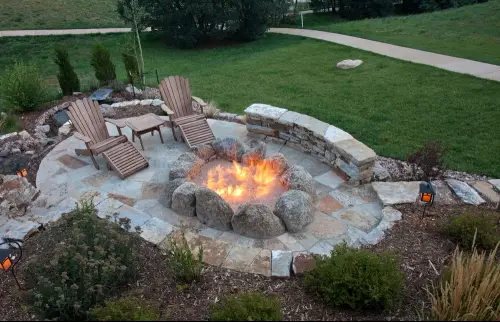Outdoor Fireplaces | Warm Up Your Deck or Patio with a Gas Fireplace

Throughout the country, homeowners are increasing their usable living space by finishing outside areas, such as with decks and patios. Some even add the heat of a roaring fire for when temperatures drop at the end of the day. If you wish to do the same, learn more about the different fireplace and fire pit options, then discuss your plans with a professional handyman.
Check Local Laws
Construction of a permanent outdoor fireplace or firepit may fall under city building codes, depending on where you live. There also may be guidelines in place to control the size of the fire, its location, what gets burned, and monitoring of the fire. Air quality and burn bans may apply on certain days. Consult your city planning department and local fire department to find out what rules exist before making any decisions.
Decide on a Fireplace or Fire Pit Design
When choosing among the many options, first consider space and budget. A large backyard with a finished patio may lend itself to a freestanding fireplace set toward the rear as a focal point. This allows to you set up a living room - complete but for the walls and roof - outdoors. You also may have space for a built-in fire pit. Brick, concrete, and/or stone typically make up the materials for permanent fireplaces and pits. In terms of design, the options are seemingly endless and limited only by safety considerations.
If your outside area does not have room for a larger, permanent structure, consider adding a portable fire pit. They come in a variety of materials and designs. Copper and cast-iron fire pits are a common sight in stores, with circular shapes the most common. The housing and grate lid can be simple or ornate in design.
In terms of cost, a permanent structure requires the most investment. These can be simple in design or feature elaborate stonework that increases the cost. Keep in mind, though, that as permanent structures on your property, they can increase the value of your home. Portable fire pits are the least expensive option and also range in price greatly. Expect copper to cost more than cast iron, as copper offers more appeal both in terms of appearance and longevity.
Gas vs. Wood
If opting for a permanent structure, you also must choose what you use to fuel the fire. Let's look at the pros and cons of gas and wood.
Gas Pros:
- You start fires and put them out in most cases with the press of a button.
- They burn clean and leave behind no residue.
Gas Cons:
- Gas-fueled fires are smaller.
- They require the installation of a permanent structure, including a gas line if opting for natural gas, which can be cost-prohibitive to many homeowners.
Wood Pros:
- Wood-fueled fires are larger.
- Wood can be burned in permanent fireplaces and firepits as well as portable fire pits.
- Portable fire pits cost must less than permanent structures.
Wood Cons:
- Starting fires requires much more than the press of a button, as does putting out the fire.
- The smell of burning wood lingers on the structure and people.
- Smoke can be bothersome.
- Regular cleanup involves disposing of ashes and cleaning out the fireplace or fire pit.
- Wood storage outside can attract bugs and wild animals.
- Burn bans apply.
Once you decide on the scale of your fireplace or fire pit project, consult your professional handyman. He or she can guide your plan, helping you make the best decisions on location, design, and type of fuel. Your handyman also will know the local laws regarding building permanent structures and help you avoid unknowingly breaking the law because you did not fully understand the codes and regulations.
Mr. Handyman can maintain your home to save you money. One call really does take care of everything on your to-do list. Make sure to stay on top of all your household repairs, improvements, and maintenance needs, and request service now online.
 Click to call
Click to call


